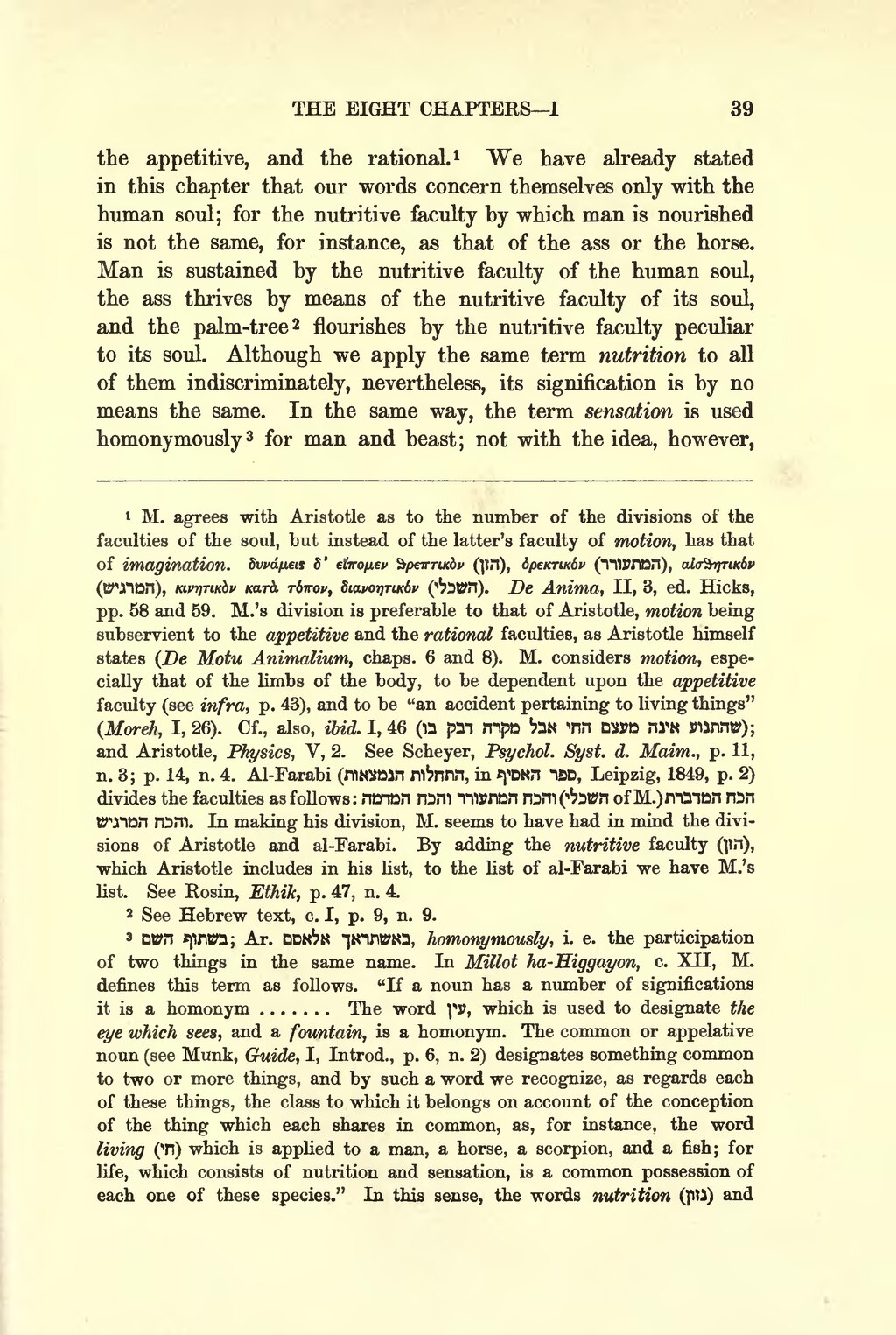This page has been validated.
The Eight Chapters—I
39
the appetitive, and the rational.[1] We have already stated in this chapter that our words concern themselves only with the human soul; for the nutritive faculty by which man is nourished is not the same, for instance, as that of the ass or the horse. Man is sustained by the nutritive faculty of the human soul, the ass thrives by means of the nutritive faculty of its soul, and the palm-tree[2] flourishes by the nutritive faculty peculiar to its soul. Although we apply the same term nutrition to all of them indiscriminately, nevertheless, its signification is by no means the same. In the same way, the term sensation is used homonymously[3] for man and beast; not with the idea, however,
- ↑ M. agrees with Aristotle as to the number of the divisions of the faculties of the soul, but instead of the latter’s faculty of motion, has that of imagination. δυνάμεις δ' εἰπομεν ϑρεπτικὸν (הזן), ὀρεκτικόν (המתעורר), αἰσϑητικόν (המרגיש), κινητικὸν κατὰ τόπον, διανοητικόν (השכלי). De Anima, II, 3, ed. Hicks, pp. 58 and 59. M.’s division is preferable to that of Aristotle, motion being subservient to the appetitive and the rational faculties, as Aristotle himself states (De Motu Animalium, chaps. 6 and 8). M. considers motion, especially that of the limbs of the body, to be dependent upon the appetitive faculty (see infra, p. 43), and to be “an accident pertaining to living things” (Moreh, I, 26). Cf., also, ibid. I, 46 (שהתנוע אינה מעצם החי אבל מקרה דבק בו); and Aristotle, Physics, V, 2. See Scheyer, Psychol. Syst. d. Maim., p. 11, n. 3; p. 14, n. 4. Al-Farabi (התחלות הנמצאות, in ספר האסיף, Leipzig, 1849, p. 2) divides the faculties as follows: הכח המדברת (השכלי of M.) והכח המתעורר והכח המדמה והכח המרגיש. In making his division, M. seems to have had in mind the divisions of Aristotle and al-Farabi. By adding the nutritive faculty (הזן), which Aristotle includes in his list, to the list of al-Farabi we have M.’s list. See Rosin, Ethik, p. 47, n. 4.
- ↑ See Hebrew text, c. I, p. 9, n. 9.
- ↑ בשתוף השם; Ar. באשתראך אלאסם, homonymously, i. e. the participation of two things in the same name. In Millot ha-Higgayon, c. XII, M. defines this term as follows. “If a noun has a number of significations it is a homonym ....... The word עין, which is used to designate the eye which sees, and a fountain, is a homonym. The common or appelative noun (see Munk, Guide, I, Introd., p. 6, n. 2) designates something common to two or more things, and by such a word we recognize, as regards each of these things, the class to which it belongs on account of the conception of the thing which each shares in common, as, for instance, the word living (חי) which is applied to a man, a horse, a scorpion, and a fish; for life, which consists of nutrition and sensation, is a common possession of each one of these species.” In this sense, the words nutrition (נזון) and
